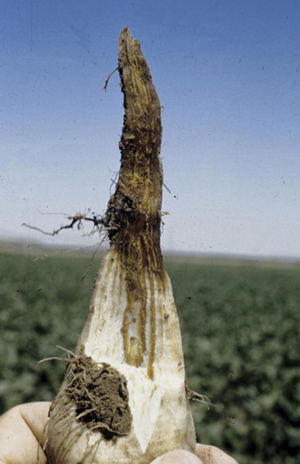G1843
Fusarium Yellows and Fusarium Root Rot
Fusarium yellows and Fusarium root rot are consistent problems in sugar beet production. This guide explores their symptoms, life cycle and management.
Robert M. Harveson, Extension Plant Pathologist
Introduction
Fusarium yellows, caused by the soilborne fungus Fusarium oxysporum f. sp. betae, was first reported from Colorado in 1931. Since that time it has been a consistently recurring problem in sugar beet production throughout the western United States. It has additionally been reported in the Red River Valley of North Dakota and Minnesota along with Michigan in the U.S., as well as in Iran, India, and most sugar beet-growing countries of Europe. The pathogen can also cause a stalk blight of beet grown for seed production in Oregon.
Fusarium root rot, caused by a different form species of F. oxysporum, (F. oxysporum f. sp. radicis-betae), was a major contributor to sucrose and root yield losses in Texas before sugar beet production in that state ceased in 1997. It was first reported in 1989, and its known distribution was thought to be limited to that region until recently. Isolates causing root rot were identified in Colorado and Montana in 2005. However, because of its likelihood of reoccurence as part of a complex with other root diseases like Rhizoctonia root rot, Aphanomyces root rot, and rhizomania, and due to its similarities to Fusarium yellows, it may easily be an overlooked threat in other production areas today. Both Fusarium yellows and Fusarium root rot can significantly reduce root yield, sucrose percentage, and juice purity.
Symptoms
Foliar symptoms of both Fusarium diseases are similar. Initially, older leaves show yellowing between the larger veins (Figure 1). Leaves ultimately become dry, brittle, and can be found heaped around the crown, but usually remain light brown (Figure 2). Frequently, only one side of the leaf is affected and appears scorched (Figure 3). The leaf scorching may be confused with that caused by A. cochlioides. However both Fusarium pathogens additionally cause internal necrosis of vascular elements (Figure 4), which is diagnostic for both diseases, effectively eliminating the possibility of either Rhizoctonia or Aphanomyces root rots.
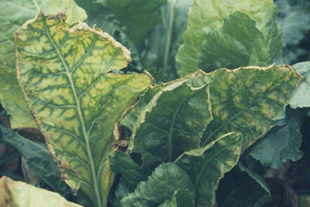 |
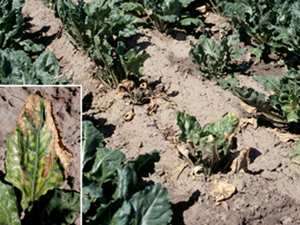 |
|
| Figure 1. Interveinal yellowing, characteristic of Fusarium yellows or Fusarium root rot. | Figure 2. Scorched, brittle leaves due to Fusarium yellows or Fusarium root rot. | |
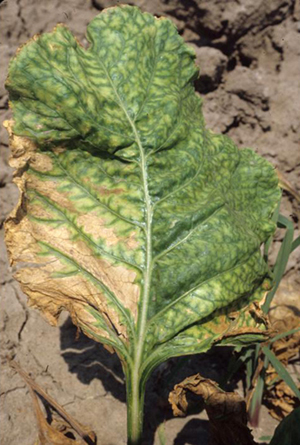 |
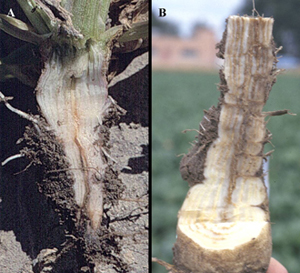 |
|
| Figure 3. Fusarium yellows or Fusarium root rot of sugar beet – one-sided wilt and scorching. | Figure 4. Vascular necrosis with no external root rot, characteristic of Fusarium yellows. Note limited necrosis in early infection (A/left) compared to advanced infection (B/right). |
|
Plants may recover at night but wilt quickly again during the day, due to vascular elements being blocked by the pathogen. Fusarium root rot is additionally characterized by a black tip rot at the distal end of the taproot in addition to the vascular discoloration (Figure 5). Fusarium yellows symptoms are limited strictly to foliar wilting, interveinal yellowing and vascular discoloration, but no rotting of the taproot.
Pathogen and Life Cycle
Although both form species of Fusarium are similar morphologically, they are distinct genetically. They survive as spherical to ovoid chlamydospores (thick-walled, resistant overwintering spores) (Figure 6) in soils. The yellows pathogen produces both straight to slightly curved microconidia (small spores) (2.5-4 x 6-15 µm) and crescent-shaped macroconidia (large, crescent-shaped spores) (3.5-5.5 x 5.5-21-35 µm).
The Fusarium root rot pathogen generally produces sparse numbers of macroconidia, but does produce microconidia (3-5 x 8-10 µm) in false heads and chlamydospores (4-7.5 x 20-30 µm).
The two pathogens were assigned different form species names to reflect their differences in genetic diversity and induced symptoms on sugar beet plants.
Disease is initiated as soils begin to warm in late spring. Optimum temperatures for infection and symptom development for most isolates are reported to be 75-80°F. Overwintering chlamydospores formed in macroconidia germinate and can infect susceptible plants. The pathogen invades roots forming new spores and ultimately resides in the vascular system (Figure 7), blocking water transpiration. High soil moisture is also necessary for adequate disease development.
Management
Genetic resistance is the most cost-effective method for disease management. However, few cultivars are available for the yellows pathogen and none to date for the root rot pathogen.
Cultural practices that attempt to modify the soil environment to the benefit of the plant and the detriment of the pathogen are effective in reducing disease severity. These techniques include planting early into cool soils, and avoiding unnecessary irrigations. Controlling several weeds such as pigweed, Kochia, and lambsquarters that can serve as hosts will also help to avoid large population increases in soils.
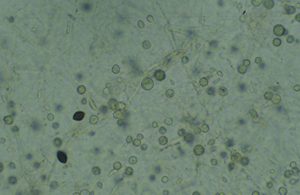 |
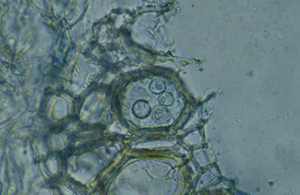 |
|
| Figure 6. Overwintering survival structures of F. oxysporum (Chlamydospores). | Figure 7. Chlamydospores found lugging xylem elements. |
Visit the University of Nebraska–Lincoln Extension Publications Web site for more publications.
Index: Plant Diseases
Sugar Beet
Issued April 2008
